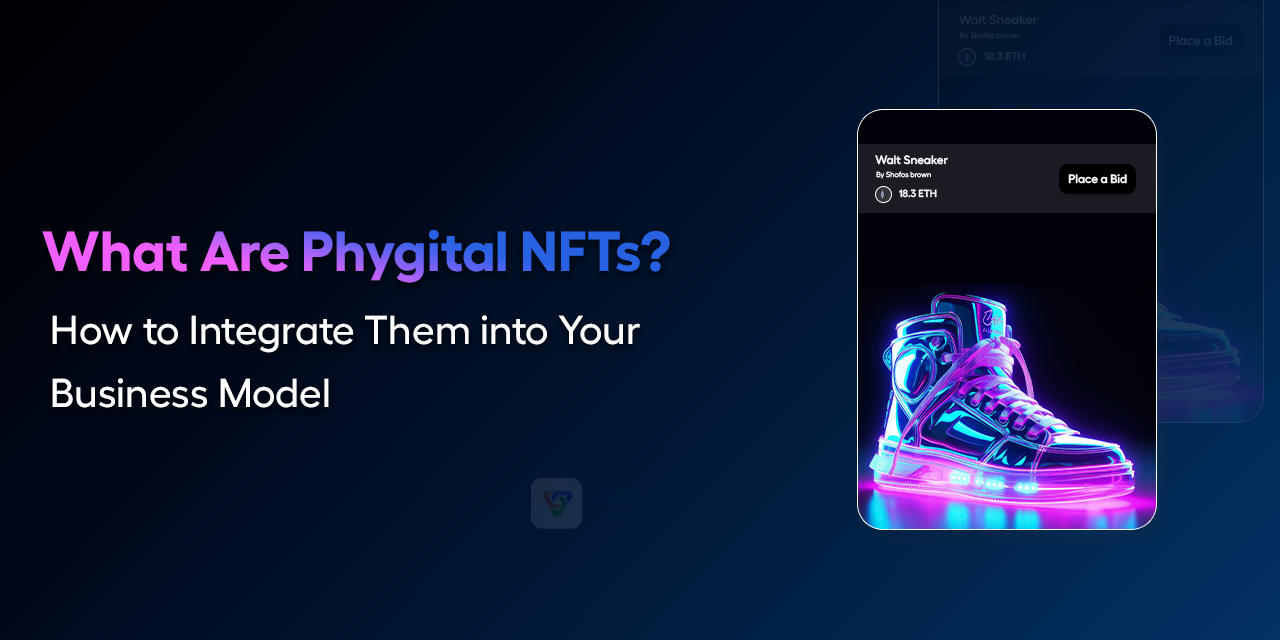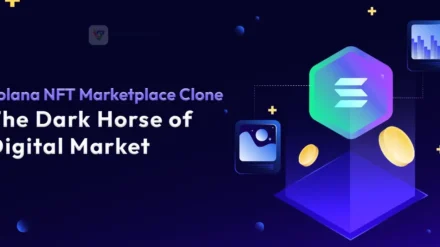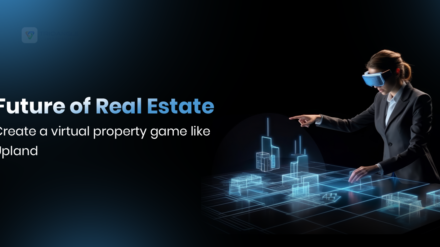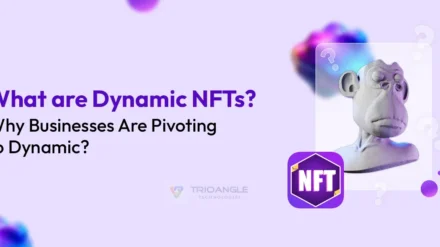In today’s rapidly evolving Web3 era, the line between the physical and the digital world is no longer a boundary… It’s a bridge. This bridge is called Phygital NFTs.
These digital-physical NFTs aren’t just the next trendy word. They’re shaping the future of asset ownership, brand experiences, and business models.
Entrepreneurs looking to stay ahead of the curve… Then you need to understand how phygital NFTs function. and more importantly, how to integrate them strategically into their ventures via the NFT Marketplace development services.
Imagine owning a luxury sneaker not just in your closet, but also in the metaverse. Or holding a digital deed that unlocks access to a smart home in real life. This is not fantasy…this is phygital reality.
This blog unpacks everything from What are Phygital NFTs to real-world use cases.. Especially in real estate. Let’s dive in and understand how you can leverage phygital NFTs for powerful, real-world outcomes.
Understanding Phygital NFTs: The Evolution of Digital-Physical Assets
Phygital NFTs are digital tokens linked to real-world items. They connect a physical product like art, sneakers, or real estate with a digital NFT stored on the blockchain. This fusion lets owners prove authenticity, trade assets online, or unlock extra perks. Making NFTs useful both online and offline.
Unlike traditional NFTs… Which only exist in the digital domain (such as profile pictures or metaverse land). Phygital NFTs attach real-world items to blockchain-verified tokens.
In Web3, this fusion of physical and digital makes ownership more interactive. For example, owning a phygital NFT may mean possessing both a virtual jacket for your avatar… and a real one delivered to your home.
Compared to fungible tokens, which are interchangeable (like cryptocurrencies). Digital-physical NFTs are unique and programmable.
A physical-digital NFT ecosystem enables traceability, scarcity, and verifiability of goods. Whether it’s fashion NFTs and phygital retail, or art… that exists both on a wall and the blockchain. Phygital assets open up new revenue paths and consumer experiences.
Blockchain and Phygital: The Invisible Glue That Binds Trust
So, What are Phygital NFTs, and how are they connected to blockchain? At the heart of every phygital NFT lies one foundational element: blockchain trust.
Unlike traditional databases, blockchain offers a tamper-proof. Transparent ledger that records the entire lifecycle of a phygital asset. From minting to ownership transfer and final delivery. This transparency builds consumer confidence and eliminates fraud.
When a physical item is tied to a phygital NFT., its authenticity and provenance become verifiable on-chain. This cryptographic linkage ensures the rightful owner of the NFT. Also owns the real-world counterpart, be it fashion, real estate, or collectibles.
To address the cost and speed limitations of Layer-1 blockchains like Ethereum. Layer-2 networks such as Polygon and Arbitrum… are increasingly used in phygital NFT marketplaces. These solutions make it workable to mint, track, and trade thousands of NFTs efficiently.
Smart contracts serve as the bridge between real-world actions and digital records. For instance, once an item is shipped or a property is accessed, the event can be logged on-chain in real time. This trust layer binds off-chain logistics with on-chain transparency.
In a world where ownership spans both physical and digital realms… blockchain acts as the invisible glue… Securing every transaction and powering the next wave of phygital innovation.
The Mechanics Behind Phygital NFTs: From Minting to Real-World Redemption
Creating a phygital NFT is more than attaching a picture to a token. It’s an engineered process combining blockchain logic, physical verification, logistics, and ownership proof. Here’s how it unfolds step-by-step:
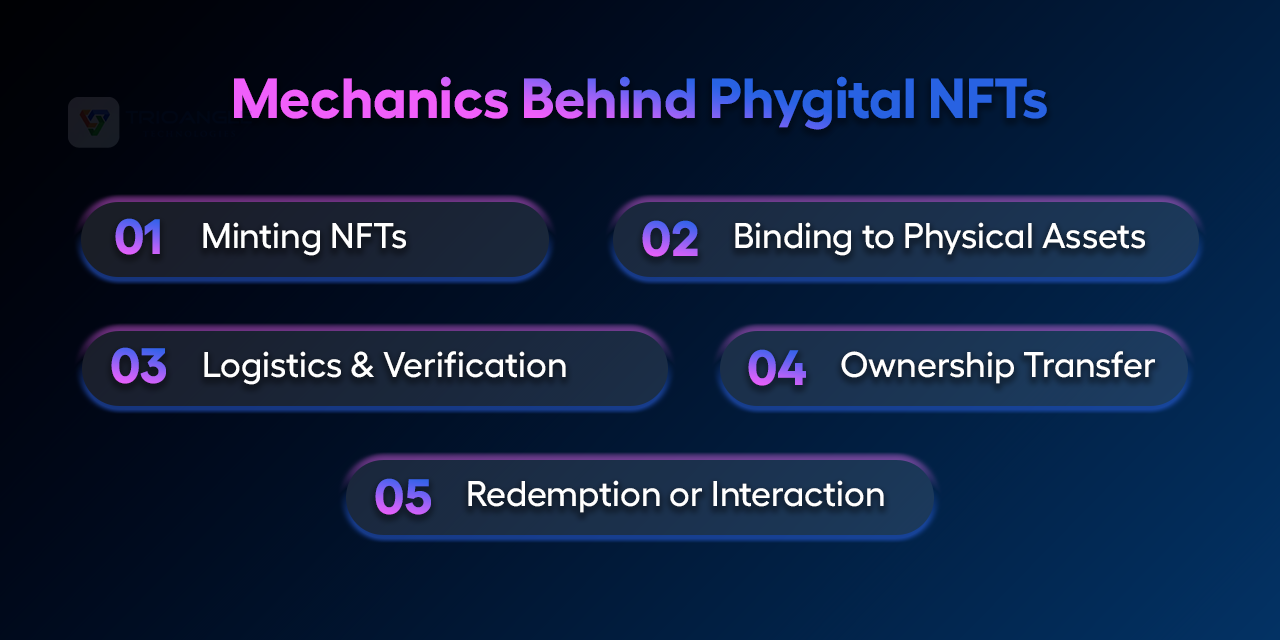
1. Minting the NFT
First, a smart contract is deployed on a blockchain. It includes metadata that represents the physical object (serial number, description, condition, creator identity, etc.). This is where your phygital NFT marketplace development begins.
2. Binding to the Physical Asset
The real-world item is either embedded with a QR code, NFC chip, or RFID tag that directly links to the minted NFT. These embedded technologies create a verifiable digital-physical connection. When scanned, they point to a unique token on the blockchain.
3. Logistics and Verification
To prevent fraud or duplication… trusted third-party logistics providers can verify and track the item. For instance, in real estate NFTs, deeds or contracts are scanned and hashed. Ensuring the real-world document can’t be forged or altered.
4. Ownership Transfer
When someone purchases the NFT, they get the right to the physical item. Either instantly (redeemable) or over time (subscription, rent, or access-based models). Smart contracts automate the transfer of rights. And trigger fulfillment steps like delivery or legal binding.
5. Redemption or Interaction
Once owned, users can either redeem the physical item (burning the NFT). or continue to hold it for resale, or interact with it digitally. Such as gaining access to a smart building, a metaverse replica, or exclusive events.
This mechanical flow is what enables NFT-backed physical assets… to go beyond art and sneakers. It’s redefining how businesses manage inventory, rent property, or verify ownership. Especially in phygital real estate NFT ecosystems.
Redeemable NFTs vs. Phygital NFTs: What’s the Real Difference?
Both redeemable NFTs and phygital NFTs bridge the digital and physical. But they differ fundamentally in how they behave post-purchase… and what rights they offer.
Redeemable NFTs
These are claim-once tokens. The moment a user redeems it say, for a physical sneaker or ticket. The NFT either becomes burned or marked as used. Their lifecycle ends with redemption. It’s like a coupon.
Phygital NFTs
These go beyond redemption. They remain active even after delivery, offering programmable or perpetual access. Imagine a luxury watch that grants the owner entry to members-only events as long as they hold the token. Or a real estate NFT that automatically pays out rent via smart contracts.
Smart Contract Architecture
Redeemable NFTs are straightforward. One-use logic. Phygital NFTs involve complex conditions… potentially integrating NFC readers, delivery tracking, and legal ownership structures.
Business Impact
Entrepreneurs should use redeemable NFTs for limited merch drops, tickets, or claims. But do you know What are Phygital NFTs? if you want to build a real estate NFT business model… offering ongoing access, utility, and community. You’ll need the phygital NFT integration approach.
Understanding this difference isn’t just technical… It’s strategic. The future belongs to those who build ecosystems, not just one-time experiences.
Wish to know how Phygital NFTs accelerate your business?
Real-World Asset NFTs: How Phygital Tech Powers Real Estate NFT Innovation
Real estate is one of the most promising sectors to adopt phygital NFTs. Why? Because physical assets like land and property already represent value… And NFTs provide the ideal infrastructure to tokenize and manage that value transparently.
With phygital NFT technology, properties can be tied to blockchain-based tokens. Creating real-world asset NFTs that include metadata, ownership rights, and even access credentials. This isn’t just digital paperwork. It’s a programmable layer of trust, transparency, and automation built into every transaction.
Entrepreneurs can launch real estate NFT marketplaces… Where each token represents a full or fractional share of a physical property. Smart contracts control everything… From ownership transfers and rental agreements to royalty payments and time-bound access. This transforms property management into a decentralized, auditable process that minimizes legal friction.
Take smart homes, for example. A single phygital NFT can grant access to digital locks, control IoT appliances, and verify guest entries. Buyers not only own the property token. But also receive physical utilities governed by the blockchain.
Even more powerful is the rise of real estate DAOs. These are decentralized communities… Where members use governance tokens (often phygital) to vote on leasing decisions, renovations, and co-living rules. Every stakeholder gets transparency and a say.
Layer-2 blockchains like Polygon make this scalable… It reduces transaction fees and processing delays that Layer-1 platforms like Ethereum can’t always handle.
What are Phygital NFTs and What makes phygital integration in real estate truly unique… is how it reduces paperwork and enhances compliance.
NFT metadata can store everything. From digital deeds and insurance policies to energy reports all verifiable on-chain.
For entrepreneurs, the benefits are clear: faster transactions, lower operational costs, and stronger buyer trust.
Phygital NFTs aren’t just a digital novelty… they are a foundational shift for real estate asset management.
By merging blockchain’s auditability with physical ownership. Phygital NFTs give property businesses a smarter, more secure path forward in the Web3 economy.
Beyond Art and Sneakers: The Most Impactful Phygital NFT Examples in 2025
While most people know of phygital NFTs through sneakers and collectibles, 2025 is showcasing deeper, high-utility use cases. Let’s explore some innovative models:
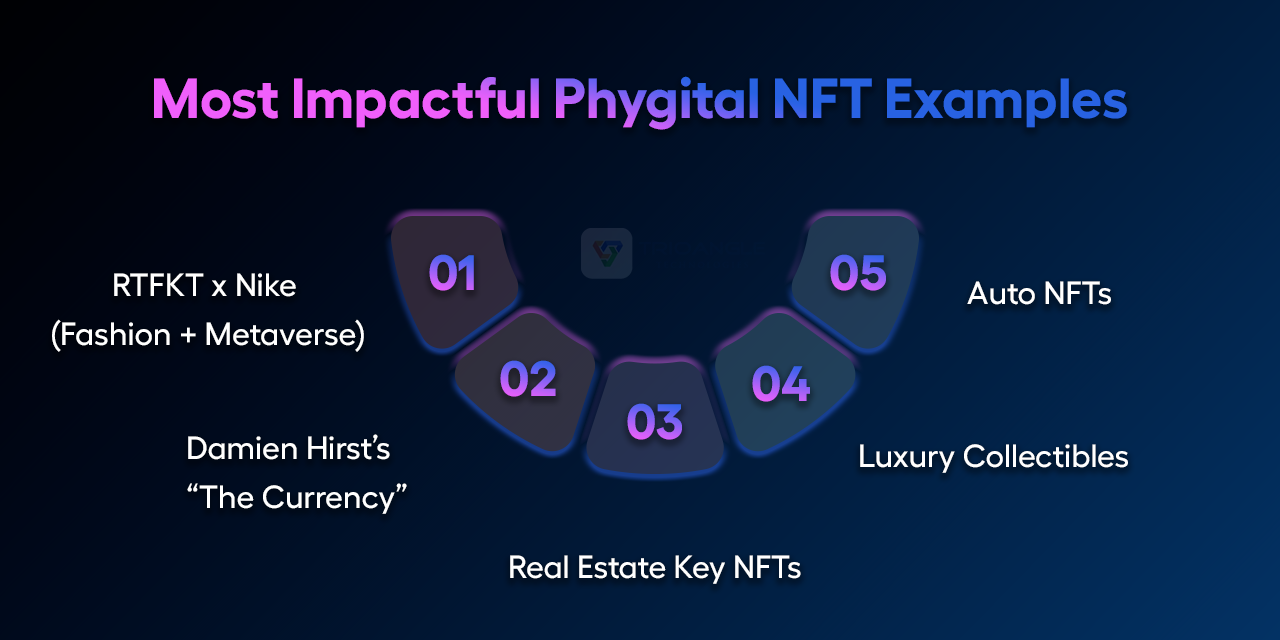
1. RTFKT x Nike (Fashion + Metaverse)
Users buy a Phygital NFT sneaker that unlocks wearables in the metaverse. The physical shoe comes with an NFC chip, and the NFT can be traded independently.
2. Damien Hirst’s “The Currency”
Collectors chose between a physical painting or its NFT twin. If you kept the NFT, the painting was destroyed. This phygital NFT example showed how ownership perception shifts when permanence is optional.
3. Real Estate Key NFTs
In pilot projects, smart home NFTs are used to unlock doors, verify guests, or authorize rentals. Each token binds blockchain logic to physical locks.
4. Luxury Collectibles
Watches, wine, and rare assets are being paired with NFT-backed physical assets for provenance. This is critical in fraud-prone sectors like jewelry.
5. Auto NFTs
Concept cars or EVs are now sold as NFTs… including service history, warranties, and resale options. All verifiable on-chain.
These examples prove phygital crypto assets are more than a novelty. They’re building the foundation of next-gen ownership models. That goes beyond artwork and into function, access, and programmable value.
Phygital NFT Use Cases in Property Business Models
Entrepreneurs in the real estate space can deploy phygital NFTs in transformative ways. Here are standout business models to consider:
#1 Smart Home Access via NFTs
Use phygital NFTs to unlock doors, control smart devices, or restrict access to verified owners. Tenants receive time-bound tokens that expire after the lease ends.
#2 NFT-Linked Rent-to-Own Models
Users pay over time and gradually earn NFT shares representing equity. Upon full payment, the NFT is upgraded to full ownership status, transparently and automatically.
#3 Real Estate DAOs
Create decentralized real estate collectives. where voting tokens are phygital. Representing real stake and in-person access. Token holders can vote on renovations, sales, or leasing strategies.
These models create a scalable NFT business model rooted in transparency and automation. By leveraging phygital NFT marketplace development services… Entrepreneurs can turn static assets into programmable, tradeable, and scalable services.
Wrapping it Up!!!
What are Phygital NFTs?. Phygital NFTs aren’t just redefining ownership. They’re reprogramming how trust flows between people, assets, and systems. By anchoring digital tokens to real-world value… Entrepreneurs can unlock secure, traceable, and immersive experiences that go far beyond traditional models.
Whether you’re innovating in real-world asset NFTs… Or reimagining property access through smart contracts, the possibilities are wide open. It’s not just about NFTs anymore… It’s about how your business becomes verifiable, tradable, and scalable in the hybrid economy.
Looking to build something tangible from this digital shift? Trioangle’s NFT marketplace development services help you launch robust, future-ready platforms. From phygital NFT integration to blockchain-backed real estate utilities. Their end-to-end support turns your vision into scalable infrastructure.
Because in this next phase of Web3, owning the future means building it—one phygital asset at a time.

